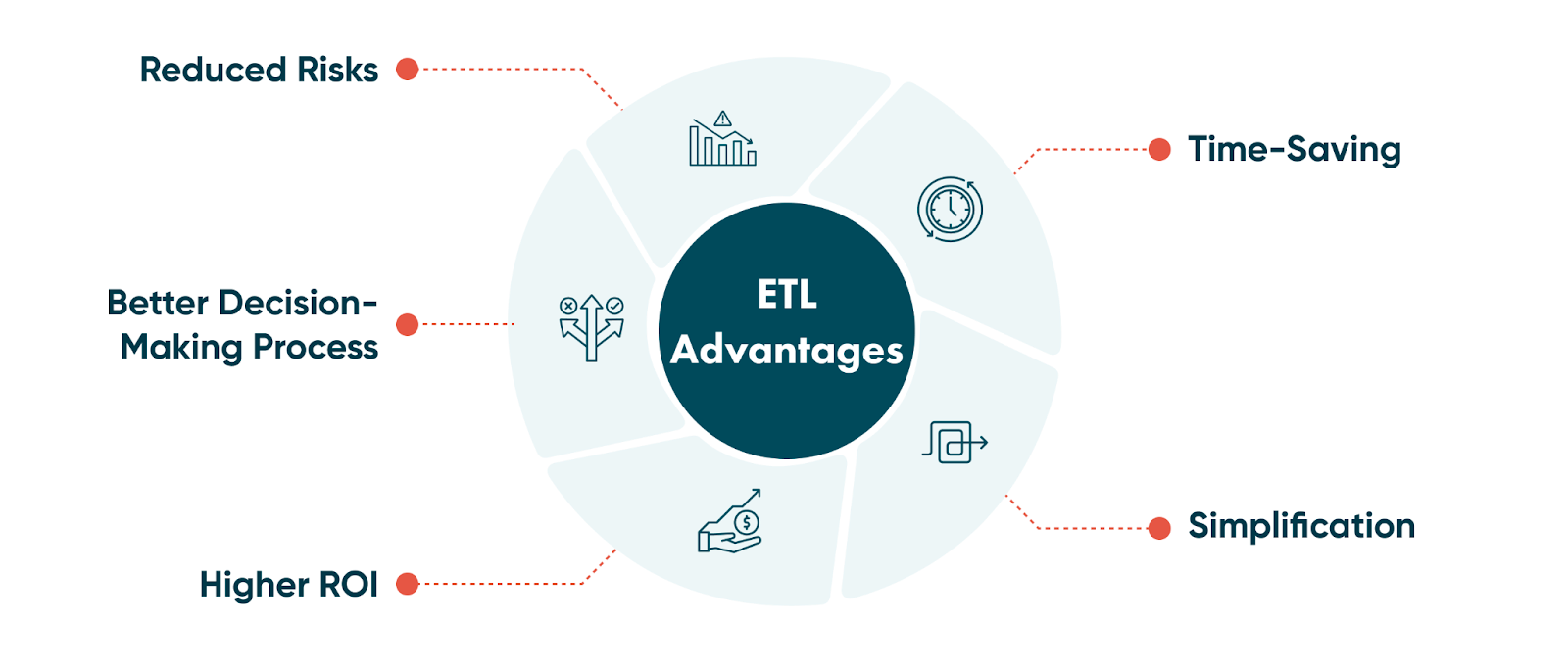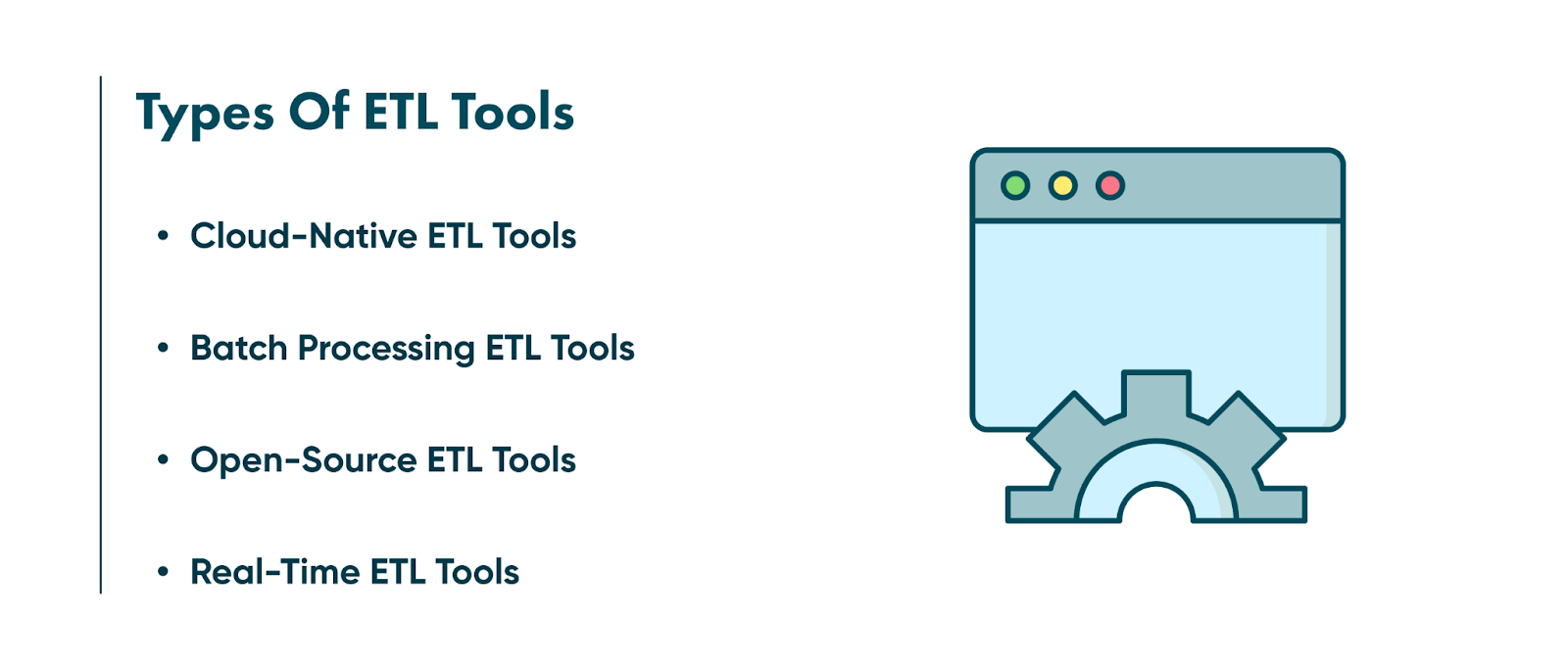Extraction, Transformation, and Loading: What ETL Is Created For and How It Works


The collection and analysis of information from different sources and departments is an integral part of many companies — particularly those working in the ecommerce sector. Data analysts process the information gathered from multiple sources and need to use the ETL process to analyse this data effectively and quickly.
If your company has to work with databases, data warehouses, data lakes, etc., then you certainly need ETL to improve the information extraction, transformation, and loading process.
We have created this article to provide a detailed definition of ETL, how you can use it, and what advantages you may gain from that use.
What is Extraction, Transformation, and Loading (ETL)?
ETL is a set of processes for data storage management, including the following:
- Data extraction from external sources (database tables, files)
- Data transformation and cleaning according to business requirements
- Processed data loading in corporate data storage
The ETL data concept arose due to the appearance of multiple corporate information systems that should be integrated to unify and analyse stored data.
Usually, ETL processes are used when it is necessary to transfer a large volume of heterogeneous data: collect it, unify it, load it to a new system and save all this information. Systems are different, and the primary ETL task is to adapt data from various sources for them.
Let’s take a shop as an example. Accounting for offline customers is kept in one format, with online customers in another. Data formats are different, as well as used devices. The data should be uploaded and transferred to a unified format if shops need to maintain a shared database. This is where the ETL database is applied.
Many free and paid ETL solutions are available (aka ETL software). Developers can create some simple ETL solutions for a specific task. However, large systems work with different data out of the box.
Thus, the applied purpose of ETL processing is to organise the unified data structure by integrating various information systems. ETL systems are critical tools for BI (Business Intelligence) when analysts at companies can monitor the business processes and gather up-to-date information.
Need a detailed consultation? Contact Go Wombat right now.
How ETL works
Regardless of the specifics of the construction and operation of the ETL system, it must ensure the implementation of 3 main stages of the ETL process:
Extraction
The ETL databases extract data from one or a few sources and transfer them to an intermediate buffer for further processing. Also, at this stage, the ETL system may implement validation and data verification to ensure compliance with the specific criteria. The system verifies whether it can upload the data into the new warehouse without loss.
Transformation
During this phase, the system modifies the data to fit the new storage requirements. ETL transformations change the format of information presentation and the encoding (if necessary), separate the data from the unnecessary, and bring everything to a single format.
Loading
The final stage is where prepared data are uploaded to new storage and placed in appropriate locations. Apart from the information itself, the ETL system can transfer metadata (information about data structure).
Thus, the ETL process means the data transfer (data flow) from the source to the recipient through the intermediary data that contains temporary auxiliary tables created solely to organise the loading process. The analyst describes the requirements for data flow arrangement. Therefore, ETL is not just a data transfer process from one application to another but also a tool to prepare data for analysis.
ETL advantages: why your business needs it
The ETL system has multiple advantages for your business, and we will list the significant benefits below.

Time-saving
The most significant advantage of the ETL process is that it saves time and effort from when data is processed manually. ETL helps you automatically collect, transform, and consolidate data. As a result, you can save time since you don’t need to import data manually.
Streamlining
The ETL system makes it easy to work with complex data. As your business grows over time, you need to work with vast amounts of complex and diverse data. For example, there can be different time zones, client names, device identifiers, and locations. Besides that, incoming data files may have other formats and types. So, the ETL process makes your work better.
Reduced risks
Regardless of how careful you are about data accuracy, none of us is immune from mistakes. For example, data can be accidentally duplicated, or you can manually input incorrect data. An ETL system makes it possible to avoid such scenarios since the process is automated and doesn’t require human intervention.
Better decision-making
ETL may ensure that the data you receive for analysis has the highest possible quality since it automates work with critical data and reduces potential errors. High-quality information is fundamental for making more effective corporate decisions.
Higher ROI
As you save time, effort, and resources, the ETL process eventually helps you increase the return on investment (ROI). Additionally, the improvement of business analytics enables you to increase your profit.
Where ETL is used
As it is already clear, the primary purpose of ETL is to facilitate data transfer from one location to another. ETL can be used in multiple sectors where you need to combine information from numerous sources, for example: ecommerce, logistics, and healthcare.

Database
Any data storage, in one way or another, faces migrations and transfers from locations. Sometimes it can be a one-time migration, but often companies have data entered into their databases from different sources all the time. When working with databases and data, the ETL process ensures it will be smooth and uniform.
Data warehouse
The data warehouse (DWH) is the place where information is stored. DWHs are specific databases for organisational purposes, internal analysis, and reporting. These are administrative and archive databases of the company. They contain essential business information. Combining the information in one place is necessary to ensure that business processes and internal analytics function correctly. In the case of DWH, the data is always taken from different sources, so ETL for data warehouses is a frequent application.
Big data
Working with big data implies its transfer among other systems. ETL systems help big data analysts and developers solve complicated tasks and manage data massifs.
OLTP/OLAP
Another ETL example is a layer between OLTP and OLAP. These systems process data, each in different ways:
- OLTP stands for online transaction processing. Systems focus on a continuous flow of small transactions, many of which are repeated.
- OLAP is online analytical processing. Unlike OLTP, OLAP is required to process substantial analytical requests with multiple parameters.
OLAP works well where OLTP fails, and vice versa, so data sometimes needs to be transferred from one system to another. This is where the ETL process is applied.
Internet of things
IoT enables the connectivity of multiple smart devices between each other. Due to IoT, devices can communicate over a local network and solve more challenging tasks than when working separately. Smart homes are created using IoT.
Data from different devices have different formats and characteristics. Therefore, you must apply ETL to store it in a single base. For example: a dashboard in a smart home that displays the information from sensors and information about the condition of all IoT devices.
Machine learning
Specialists in AI and machine learning sectors operate huge data massifs called datasets. These data should be processed, uploaded, and used for learning and analysis. Here ETL is used to migrate data to a single warehouse when creating a dataset, for example.
Cloud technologies
Today cloud services are used to store different types of data. They replace on-premise storage. Most companies actively migrate their data to the cloud, using ETL solutions to transfer all data from different sources.
Analytics
You can use ETL data analysis, marketing analysis and other types of analytics. Analytics means a large amount of information gathered from various sources: it needs to be compared and analysed, and then predictions are made on its basis. Therefore, ETL is used in this field to process all available information.
Our experts in ETL will help you deal with all the issues you have. Contact Go Wombat.
Types of ETL tools
Not all ETL tools are the same. There are 4 different types, and they work in different environments. You should choose the one that meets your requirements most. Here is a list:

Batch processing ETL tools
This type was used widely until very recently. Batch processing was performed in on-premises tools, which means that all the data gathered during the day was synchronised during off-hours (at night). The reason for this is that the processing of large data volumes takes a lot of time and resources. Today cloud-based tools replace batch processing since they allow specialists to do real-time extraction and processing, while batch processing can be the reason for outdated information. However, batch processing is still used by some today.
Cloud-native ETL tools
As mentioned above, cloud-native ETL tools are a new generation of the ETL process. Cloud-based tools can extract and load data from sources directly to data storage. Then, the ETL app may transform data using the cloud scale, which is very important when working with big data, for example. Cloud-native ETL tools can be deployed in the company’s cloud infrastructure or be hosted like SaaS.
Open-source ETL tools
When speaking about ETL, open-source tools mean a low-cost solution instead of commercial ETL applications. As a result, open-source ETL tools are used widely in businesses today. Apache Airflow and Apache Kafka are good examples. However, such tools have one drawback — they may have limited features, and enterprises may run into problems when they need to extract and transform large data amounts.
Real-time ETL tools
Everything is simple here — this is another replacement for batch processing tools, and real-time tools allow processing with a distributed model and streaming capabilities in real-time. This option is vital for the financial sector especially. However, it shouldn’t be used in every case. As we said — everything depends on your requirements.
How Go Wombat can help you
Whoever owns the information owns the world, remember? Therefore, companies must be aware of the data they gather if they want to succeed. To deal with enormous data amounts, the ETL process helps you extract and transform all this information into valuable insights to boost your business.
However, this process remains challenging, and you need the assistance of a skilled software development company that has data scientists and business analysts to use your data correctly in your business's favour.
Go Wombat is the right company to cooperate with. We focus on full-cycle development and can create your software from scratch, considering all the technical nuances. In addition, business intelligence and advanced analytics are included in our services, so we can make software that will deal with data efficiently.
Got questions? Let Go Wombat be your consultant. We’re looking forward to working with you — contact us!
Unlock Success with Premium Software Development
Contact us


FAQ
What is ETL, and how does it work?
ETL stands for extract, transform, and load. It is the process when data is extracted from one or several locations. Then, extracted data is transformed to fit the targeted data warehouse. After that, it is loaded into the data warehouse so this information can be used for analytics and reporting.
What is an example of ETL in use?
When you need to synchronise data from multiple sources and there are two different databases, using the ETL system, you easily unite these databases, and information will be migrated correctly.
Why is ETL important?
ETL systems enable an efficient data management process so that massive data amounts can be processed quickly. The importance of ETL is in its opportunities for making data scientists’ work easier when they assess and analyse data. The ETL system may turn raw data into business intelligence to help companies improve their decision-making processes.
How can we help you ?




